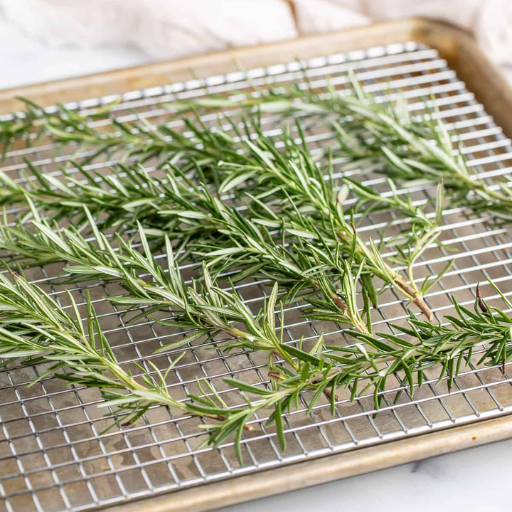Fresh herbs play a crucial role in enhancing culinary dishes by enriching flavors and adding complexity to recipes. In that context, rosemary is unique for its smell and pungent taste, which makes it popular in diverse cuisines. The reality is that it might be hard to keep rosemary fresh when growing it at home. This blog will guide you on the quickest way to dry freshly harvested rosemary so it can be used throughout the year. It doesn’t matter if you are a regular cook or a chef; knowing how to dry out your rosemary will ensure you have this amazing herb available for cooking even after the harvesting period.
How to Harvest and Prepare Fresh Rosemary
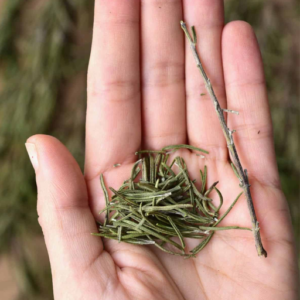
Image source: https://www.alphafoodie.com/
The best time to harvest rosemary is early morning, before its leaves get washed with dew, and before noon. To be good, begin picking with vigorous branches, which are normally four inches long but also six inches long. Cutting the stems off above leaves encourages further growth, so they should be taken closer to leaf nodes using clean scissors or pruning shears. After collecting them, rinse them in cold water to remove any soil particles or insects, then gently dab their ends with a small towel until they dry. Alternatively, you could use the fresh rosemary immediately; instead, let us go ahead and dry it for more extended storage.
How to harvest rosemary sprigs for drying
There are steps for effectively harvesting rosemary sprigs for drying.
- Timing: For the best results, pick rosemary in the morning when there’s a good oil concentration. Wait until the dew has dried, but not long before it turns hot.
- Choosing Sprays: Choose intact, mature stems with abundant foliage. Select sprays about 4 to 6 inches long as they give out more smell and taste better.
- Cutting: Use clean, sharp scissors or garden cutters to shear just above a leaf bud. This is important because harvest is done here, and new growth is encouraged.
- Cleanse: Rinse gently under cool water to remove dirt and any insects on them. Avoid spoiling the leaves.
- Dry Preparation: Blot the herb dry using a tidy paper towel or linen cloth after rinsing. Do not crush the leaves; smashing will reduce their fragrance utility.
Following these steps guarantees well-harvested rosemary sticks, which can be dried and stored for future culinary purposes.
How to pat dry and prepare rosemary leaves
Wash the picked sprigs in cold water to efficiently pat dry and prepare rosemary leaves to remove any residual soil or pests. Once cleaned, blot off their moisture using a clean paper or a napkin. Take care not to squeeze them, as it will release the oil responsible for their aroma. If you prefer, you can either take off all leaves from the stem for immediate utilization or leave the whole sprig to dry. If you‘d instead strip them down, grip at the top of the stem, then move your fingertips downward where they will come out easily. Keep these stalks in an airy room free from direct sun, or simply chop up the greens into small pieces and store them inside tightly closed jars that are convenient for use in cooking.
Tips on removing leaves from the stem
- Use Your Fingers: Grasp the top of the stalk and slide your fingers down to remove the leaves; this way, you can take them off without spoiling.
- Scissors for Accuracy: Using clippers is better if you prefer a tidy cut. This is particularly useful for thicker-stemmed plants or when a certain number of leaves are required.
- Start by Washing and Drying: If your rosemary has dirt or any other matter, wash it first before removing the leaves. Pat dry the sprigs so that they do not slip from your hands while removing the leaf, making it easier and more controlled.
This method easily removes the rosemary’s stem while maintaining its flavor and fragrance for cooking purposes.
What Are the Best Methods to Dry Rosemary?

There are various effective ways in which you can dry rosemary, each with its advantages:
- Air Drying: Gather individual rosemary sprigs and tie them together with string, tying them at one end. Turn these bundles upside down and place them in cool, dark, well-ventilated places. This method ensures that essential oils remain intact as air circulates naturally.
- Oven Drying: Preheat the oven to minimum heat (180°F or 82°C). Spread rosemary leaves onto a baking sheet lined with parchment paper until even. Put the sheet inside the oven with the door slightly open, and be very watchful. It is fast but could lose some aromatic oils.
- Dehydrator: If you have a food dehydrator at home, one of the most efficient ways to dry rosemary is to set the temperature at herb drying mode (usually about 95°F or 35°C) according to the instructions provided on the equipment, placing bunches in a single layer horizontally. The dryer provides a uniform environment for drying, ensuring optimum flavor retention.
- Microwave Drying: For a quick method, place two sheets of kitchen paper between which are sandwiched several layers of fresh Rosemerry leaves and microwave for low-powered heating for about 1-2 minutes, checking often. This method is quick but requires careful attention to prevent overheating, which can lead to loss of flavor.
Therefore, choosing a given method depends on the availability of equipment and personal preferences; this way, you will have finished dried rosemary in your kitchen ready for use.
How to dry rosemary in the oven
The following simple steps ensure that rosemary is dried in the oven to perfection:
- Heat Oven: Ovens are often set at 180°F (82°C), which is the lowest heat in this case.
- Clean Rosemary: Wash the rosemary sprigs under cold tap water to remove any grime. Wipe them with a dry paper towel to remove extra moisture.
- Bake Sheet Arrangement: Spread the rosemary leaves on a baking sheet lined with parchment paper. Make sure they are well spread apart for proper air circulation.
- Sun Drying Process: Slide the tray into the preheated oven. The door of the stove should be slightly open in order not to avoid condensation and promote the movement of hot air. It will take approximately fifteen minutes before you go back and check it. It might even stay for one or two hours before it dries completely, and if it does, that means that the leaves crumble easily between your fingers
- Cool and Save: Once it has dried up, remove it from the oven and let it cool down.Store these dried leaves in an airtight container away from light and moisture to keep their flavor and smell intact.
This method is quick, so it provides you with a quick way of having aromatic dried rosemary in your kitchen cupboard for use in various culinary applications.
Using a food dehydrator to dry herbs
A food dehydrator is an efficient and effective tool for drying herbs and retaining their flavor and nutrients. Here’s how:
- Gather the leaves: Begin by washing your herbs thoroughly in cold water to remove dirt or chemical residues. Then, take a clean towel and lightly pat them so as not to retain too much moisture.
- Remove the stems from the leaves: This ensures equal drying. For the most desirable outcomes, only make use of freshest and strong leaves.
- Set the Dehydrator: Arrange herb leaves on trays in one layer without overlapping, then adjust the dehydrator accordingly. Your drier should be set at a temperature between 95°F and 115°F (35°C to 46°C), which is ideal for most leafy herbs.
- Time duration for drying: The total hours it takes to dry fully varies depending on the kind of herb being used and humidity levels, but generally speaking, it ranges from around four to eight hours. Check herbs consistently for brittleness and breakability, which means they are ready.
- Storage: When they are completely dry, allow them to cool down before you put them into an airtight container. If you want to keep their freshness intact, put them away in well-sealed bags or jars kept in dark, cool places.
Not only does using a food dehydrator effectively preserve herbs, but it also allows one to process large volumes at once, which is why many homeowners prefer it over other methods available for drying purposes.
Traditional air-drying methods
Preserving herbs in a way that does not interfere with their natural flavors and scents can be done through traditional air drying, which is simple and cheap. The following are some of the steps involved that have been taken from commonly cited practices:
- Harvesting: Choose the right time to harvest your herbs. They are usually harvested in the morning after the dew has gone but before it becomes too hot. This ensures the plants are at their peak flavor.
- Bunching: Pull together stems into small groups and hold them using elastic bands or strings. Smaller bunches allow for better air circulation, which is important during drying.
- Hanging: To prevent loss of color and flavor, hang the bunches upside down in a warm, dry area with good ventilation away from sunlight. Suitable places often include attics, kitchens, or covered porches.
- Drying Time: Generally, it takes about one to three weeks for herbs to dry completely, depending on humidity levels and temperature. You will know they have dried well enough when their leaves become brittle and crumble easily.
- Storage: When dried, remove leaves from stems and put them in airtight containers. Store them in a dark, cool place for prolonged preservation of their taste and efficacy.
Traditional air drying helps keep your herbs fresh and provides an opportunity to preserve the wealth of your garden personally.
How to Use a Dehydrator for Drying Fresh Rosemary
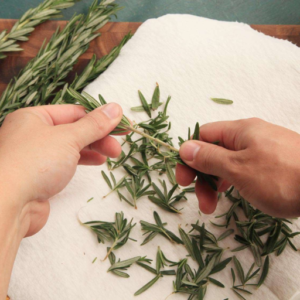
Using a dehydrator, you can dry fresh rosemary while keeping its smell and taste. This guide provides an easy way to do it.
- Washing: Fresh rosemary should be rinsed in cold water to remove dirt or bugs. To decrease moisture, gently dry the leaves with a clean cloth or paper towel.
- Trimming: Pull off the leaves from the hard stems. If you want finer pieces, chop them up.
- Setting Up Dehydrator: Evenly spread out the rosemary over trays in your dehydrator so that it is not piled on top of itself, as this prevents good airflow.
- Temperature Setting: For best results, set the dehydrator between 95°F -115°F (35°C-46°C).
- Drying Time: Check every hour after two hours for readiness and give about four hours for drying until brittle crumbs fall apart easily when touched.
- Storage: Transfer dried herbs into airtight containers kept cool and dark, which lasts several months without losing flavor
A dehydrator helps keep essential oils intact, thus providing high-quality dried herbs for cooking.
Setting up your dehydrator trays
Following certain steps when arranging your dehydrator trays is important to ensure consistent and efficient drying of food.
- Use the Right Trays: Check if you use baskets explicitly made for your food dehydrator model. Some may come with different ones for drying fruits, vegetables, or herbs.
- Strategically Place Foods: Evenly distribute rosemary (and other spices) throughout the trays. Do not overlap them or place one on top of another because this will restrict air flow, causing unevenness during the dehydration process and preventing good ventilation between pieces.
- Prioritize Even Spacing: It is better to lay herbs flat than pile them into layers. Additionally, if more than two kinds are being dried at once, they should be kept apart from each other on separate racks as this might cause mixing flavors otherwise.
- Check For Obstructions: Make sure that no big chunks exist that could obstruct movement within the airflow surrounding them. When placing more oversized items with rosemary, always cut those down so all have similar sizes. This guarantees equal treatment during their processes; only some may get enough exposure. In contrast, others remain moist due to lack thereof, thus leading us back again to our initial problem here —i.e., poor quality results!
- Follow Manufacturer Instructions: You must strictly follow what’s written in the manual provided with your machine regarding how many levels/tiers can be loaded safely without compromising performance efficiency due to overloading, which occurs later after usage has begun.
Setting up dehydrator trays properly helps ensure efficient drying of spices while preserving their taste and scent.
Optimal drying time for rosemary leaves
Depending on the dehydrator temperature settings and moisture content in rosemary leaves, optimal drying time can be anywhere between one to four hours. Most sources suggest around 95°F to 115°F (35°C to 46°C), which preserves essential oils and flavor. The leaves should feel crispy and easily crumble apart when completely dried, so check them regularly. If thicker stalks or larger batches are being dried, it will take longer; thus, rotating trays are recommended while checking for doneness often so that all rosemary pieces dry evenly.
How to tell when rosemary is fully dried
The texture of your rosemary, along with its aroma, helps you determine whether it has fully dried out or not. These indicators include:
- Crisp Texture: When touched, leaves should feel dry and brittle. When rubbed between fingers, they should crumble easily, which indicates complete dryness.
- Deep Aroma: Once fully dried, rosemary will produce a strong, fragrant smell. A faint or musty scent may indicate insufficient drying.
- Color Change: Dried rosemary may look slightly dull, but vibrant colors must still be present. Otherwise, very dark brownish hues suggest over-drying, which can negatively affect flavor.
Check regularly for these signs to ensure potency and taste retention during the drying process.
What Are Some Effective Ways to Dry Rosemary Without an Oven?
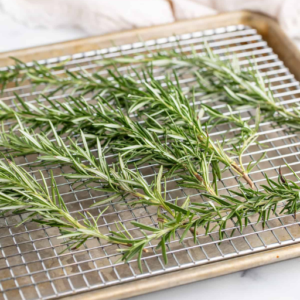
Here are some alternatives for drying rosemary without an oven, which help maintain the herb’s flavor and scent.
- Air Drying: Take small bunches of rosemary and tie them together with string. Hang upside down in a warm, dry place that is well-ventilated and away from direct sunlight. Depending on humidity, this could take one to two weeks.
- Food Dehydrators: Food dehydrators work great for drying herbs like rosemary because they allow you to control temperatures more accurately than other methods can provide. Lay out sprigs so they don’t touch each other on their designated trays within the device set at about 95°F-115 °F (35°C-46 °C). Check back occasionally until you are done!
- Microwave Drying: Put some fresh rosemaries between 2 sheets of paper towels, then cook them in the microwave for short intervals, such as 15 – 30 seconds, until completely dried out. Be careful not to burn them, as it’s easy due to the high heating power involved here. Hence, this technique should only be used when you have no time left whatsoever!
- Using A Fan: Arrange your twigs onto either a rack explicitly made for drying or any kind of basket that allows air to flow around all sides equally, then put it in front of a fan, blowing cool air towards its direction constantly until everything becomes crispy enough!
These techniques work well if you want nicely dried rosemary while keeping its fragrant properties intact and at least somewhat close to its original state before starting the process mentioned above.
How to dry rosemary in the microwave
To preserve taste and aroma, microwave drying rosemary is a rapid and effective technique. To do this:
- Prepare Sprigs: Take fresh rosemary sprigs and wash them gently under cold water to remove dirt or other foreign materials. Use a paper towel to absorb moisture.
- Arrange Leaves: Place the sprigs between two layers of kitchen towels, not too close together, as that will impact how well they dry.
- Microwave: Use the lowest power setting on your microwave. Heat the rosemary for short intervals, generally 15-30 seconds. After each interval, check if it’s getting drier by looking at its leaves, which should become crispy and easy to crumble once fully dried.
- Cool and Store: Once dried completely, allow it to cool down before storing it in an airtight container away from light so that its flavor can be preserved.
This method is best for those who want quick results but still have properly dried rosemary for cooking.
Alternative methods for drying rosemary at room temperature
- Air Drying: One of the easiest and simplest ways to dry rosemary is air drying the sprigs. Gather a handful of fresh rosemary and tie the stems together with string. Hang the bundle upside down in a warm, dry, well-ventilated space away from direct sunlight. This can take a few weeks but keeps essential oils in the herb.
- Use of a Dehydrator: If you have one, a food dehydrator can be an awesome tool for drying rosemary at room temperature. Just lay out your rosemary sprigs in one dehydrator tray in a single layer, then set it on a low temperature so that the herbs will evenly dry over several hours.
- Oven Drying: While technically not “room” temperature, using an oven on its lowest setting can be another option for those who want something faster but are still mindful about heat levels. Spread some rosemary across a baking sheet and leave the oven door slightly ajar to ensure airflow; monitor closely until the leaves feel brittle/dry/crumbly when touched.
These methods offer different options for getting beautifully dried rosemary that retains its culinary flavor & aroma use.
How to Store Dried Rosemary Properly
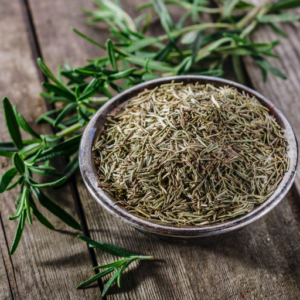
The flavors and aromas of dried rosemary can only be preserved through proper storage. First, put the dried rosemary in an airtight container like a glass jar or a spice holder with a tight lid. Keep the container somewhere cool and dark – away from direct sunlight, humidity, and strong smells that could spoil the herb’s quality. For optimal results, use your dried rosemary within six months to one year while checking for any signs of diminished potency or fragrance before using it. If you want to track its freshness, label the jar with when you stored it.
Tips on storing dried rosemary in an airtight container
- Choose Containers Wisely: Dark glass jars are best as they block light and preserve herbs’ effectiveness longer than clear containers will. Silicone or rubber-sealed lids also provide added moisture-proofing benefits.
- Store Cool and Dry: Find a pantry or cupboard where the temperature stays consistently low without being dampened by stove heat, sink steam, or fridge drafts.
- Minimize Opening: Try not to open more often than necessary so air doesn’t get in too much at once, which can cause mold growth on top of the rest of your stash if left unsealed long enough after each use; alternatively, split into smaller jars if frequent usage is expected.
- Watch for Freshness: Give those little green bits periodic glances now and again, looking specifically for clumps caused by excess wetness. If detected, note whether the smell has changed since purchase. Otherwise, it’s time to toss out old plants past their prime stage post-harvest season anyway!
-
Label and Date Markers: Always write down what kind/brand plus date bought best used before next year on all packages containing spices/herbs used during cooking sessions involving food prep work done inside kitchens worldwide today!
Best practices to keep your dried herbs fresh
- Store in an Airtight Container: The only way to keep herbs fresh is in dark glass or opaque airtight materials. Light and moisture degrade their potency. Make sure the lid is tightly closed at all times.
- Maintain Ideal Storage Conditions: Herbs should be stored in a cool, dark, dry place like a pantry or cupboard. Do not store them near heat sources such as stoves or ovens because fluctuating temperatures can affect flavor.
- Use Within Recommended Timeframes: Dried herbs usually stay good for 1 to 3 years, depending on the type. For best flavor, use within six months to one year, but check often for loss of aroma/potency.
- Minimize Exposure to Air: Limit your exposure to air and moisture by opening containers less often. If you frequently use certain herbs, consider keeping smaller portions in separate containers.
-
Label Containers: Clearly label containers with the herb’s name and date of storage to help manage your herb inventory and ensure its freshness when used.
How long can you store dried rosemary?
When stored in the right conditions, such as a cool, dark place and an airtight container, dried rosemary can last for 1 to 3 years. However, it is best used for maximum flavor and potency within six months to one year. For freshness, always check for any changes in smell or appearance, and consider marking your container with the storage date to track how long it has been there. If you want to keep your dried rosemary good longer, make sure you are storing it properly.
Ways to Use Dried Rosemary in Your Cooking

Dried rosemary adds great taste to many dishes. Here are some ways you can use it:
- Roasted Vegetables: Sprinkle some on top before roasting vegetables for extra aroma.
- Soups and Stews: During cooking, add a teaspoon of dried rosemary into thick soups or stews, which will permeate them with flavor.
- Meat Marinades: Mix together olive oil, garlic, and lemon juice, and then add this mixture so that chicken, lamb, and pork become flavorful through aromatics from herbaceous compounds found within rosemaries’ petals!
- Bread and Focaccia: Delightful herbal notes arise when mixing Rm into bread dough or sprinkling over focaccia before baking.
- Potatoes: Simple yet delicious sides can be achieved by tossing boiled/roasted spuds in Olive Oil + Dried Rosemary
With its distinctive flavor and fragrance, dried rosemary raises the quality of meals significantly, making it a multi-purpose spice in any kitchen!
Common recipes that use dried rosemary
- Rosemary Garlic Roasted Chicken: This flavorful dish involves marinating chicken with dried rosemary, garlic, olive oil, and lemon. Roasting the chicken allows the herbs to permeate the meat, resulting in a tender and aromatic meal.
- Lemon Rosemary Grilled Shrimp: Combine dried rosemary with lemon juice, olive oil, and garlic to create a zesty marinade for shrimp. Grill the shrimp until cooked, and serve them over a bed of greens or with a side of rice for a refreshing meal.
- Rosemary-Infused Olive Oil: Combine the two ingredients in a jar and let them sit for a week to infuse olive oil with dried rosemary. This infused oil can be used for drizzling over salads, bread, or pasta, adding a rich herbal flavor.
These recipes showcase the versatility of dried rosemary and how its distinctive taste can enhance a variety of dishes.
Can dried rosemary replace fresh rosemary in recipes?
Dried rosemary can be a suitable substitute for fresh rosemary, but adjustments are necessary due to the differences in potency and moisture content. Typically, the conversion ratio is 1 teaspoon of dried rosemary for every tablespoon of fresh rosemary. Since dried herbs are more concentrated, using less when substituting is important. Furthermore, dried rosemary benefits from longer cooking times, which allow its flavors to develop fully, while fresh rosemary can be added later in the cooking process for a brighter taste. In summary, while they may be replaced, carefully considering quantity timing can help achieve the desired flavor harmony in your dishes.
Ideas for incorporating dried rosemary into your meals
- Soups and stews: The flavor depth can be added to soups and stews by using dried rosemary. As it simmers, the strong taste of this dish pairs well with vegetables, meats, and legumes. Also, it infuses an aromatic essence into the meal.
- Roasted vegetables: Oil, olives, and salt are tossed in seasonal produce before roasting them together with dried rosemary on root. The herb enhances the vegetables’ natural sweetness, creating a savory side dish.
- Bread and crackers: Dried rosemary can be incorporated into bread dough or sprinkled onto crackers before baking. This adds a fragrant touch that elevates the taste, making it perfect for dipping snacks.
- Marinades: For meats or tofu, mix marinating spices using dry rosemary, oil, olives, balsamic vinegar, and other ingredients. Allow the protein to soak in this mixture to achieve a beautiful blend of flavors.
-
Focaccia and pizza: To use dried rosemary as a topping for focaccia or pizza, you need to mix it in the dough and sprinkle some more at the top to impart delightful herbal notes that will complement other toppings.
Frequently Asked Questions (FAQs)
Q: What is the best way to dry fresh rosemary quickly?
A: An oven or microwave is the best way to dry fresh rosemary quickly. Compared to air drying, these methods expedite the drying process and ensure the rosemary is dry and brittle.
Q: How can I dry rosemary in the oven?
A: To dry rosemary in the oven, preheat the oven to the lowest temperature, around 180°F (80°C). Spread the rosemary leaves in a single layer on a baking sheet and place in the oven for 30 minutes to 1 hour until the leaves are dry and brittle.
Q: Can I use a microwave to dry rosemary?
A: Yes, you can dry rosemary in the microwave. Place the rosemary leaves in a single layer between two paper towels and microwave on high for 1–3 minutes, checking every 30 seconds to ensure the leaves are dry and brittle.
Q: How do I air-dry rosemary?
A: To air-dry rosemary, tie the sprigs into small bundles and hang them upside down in a well-ventilated area. It usually takes two to three weeks for the rosemary leaves to become completely dry and brittle.
Q: What is the food dehydrator method for drying rosemary?
A: Another efficient method to dry rosemary is to use a food dehydrator. Spread the rosemary leaves in a single layer on the dehydrator trays and set the temperature to around 95°F (35°C). The leaves usually take about 1-4 hours to dry completely.
Q: How do I know when rosemary leaves are dry?
A: Rosemary leaves are dry when they are brittle and can easily be crumbled between your fingers. If they are dry and brittle, they are ready for use or storage.
Q: Should I rinse the rosemary before drying?
A: It’s advisable to rinse the rosemary to remove any dirt or pests. Pat dry the rosemary with a paper towel before using any drying method.
Q: How do I remove the leaves from the stem?
A: Once the rosemary is dry, you can easily strip the leaves from the stem by running your thumb and forefinger down the length of the stem in the opposite direction of leaf growth.
Q: How can I store dried rosemary?
A: Store the dried rosemary leaves in an airtight container in a cool, dark place. This helps preserve their flavor and aroma for more extended periods.
Q: What are some ways to use dried rosemary?
A: Dried rosemary can be used in various culinary applications, such as seasoning meats, making rosemary salt, adding soups and stews, or infusing oils and vinegar for extra flavor.













